bottomness of −1 . What is its quark configuration?
(b) What is the uncertainty in the energy due to the short lifetime?
(c) Write the decay in terms of the constituent quarks.
41. (a) What particle has the quark composition u- u- d- ?
(d) Verify that baryon number, lepton numbers, and charge are
(b) What should its decay mode be?
conserved.
42. (a) Show that all combinations of three quarks produce integral
charges. Thus baryons must have integral charge.
27. One decay mode for the eta-zero meson is η 0 → π 0 + π 0 .
(b) Show that all combinations of a quark and an antiquark produce only
(a) Write the decay in terms of the quark constituents.
integral charges. Thus mesons must have integral charge.
(b) How much energy is released?
33.6 GUTs: The Unification of Forces
(c) What is the ultimate release of energy, given the decay mode for the
pi zero is π 0 → γ + γ ?
43. Integrated Concepts
The intensity of cosmic ray radiation decreases rapidly with increasing
energy, but there are occasionally extremely energetic cosmic rays that
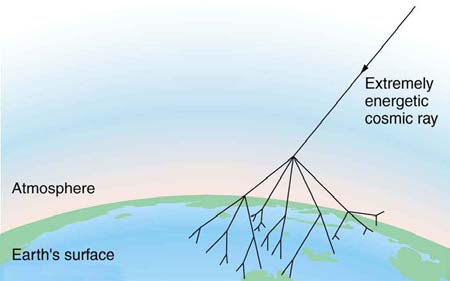
1208 CHAPTER 33 | PARTICLE PHYSICS
create a shower of radiation from all the particles they create by striking a
this? (c) If the actual lifetime is 1033 y , how long would you have to wait
nucleus in the atmosphere as seen in the figure given below. Suppose a
on an average to see a single proton decay?
cosmic ray particle having an energy of 1010 GeV converts its energy
50. Integrated Concepts
into particles with masses averaging 200 MeV/ c 2 . (a) How many
In supernovas, neutrinos are produced in huge amounts. They were
particles are created? (b) If the particles rain down on a 1.00-km2 area, detected from the 1987A supernova in the Magellanic Cloud, which is
how many particles are there per square meter?
about 120,000 light years away from the Earth (relatively close to our
Milky Way galaxy). If neutrinos have a mass, they cannot travel at the
speed of light, but if their mass is small, they can get close. (a) Suppose
a neutrino with a 7-eV/ c 2 mass has a kinetic energy of 700 keV. Find
the relativistic quantity γ =
1
for it. (b) If the neutrino leaves
1 − v 2 / c 2
the 1987A supernova at the same time as a photon and both travel to
Earth, how much sooner does the photon arrive? This is not a large time
difference, given that it is impossible to know which neutrino left with
which photon and the poor efficiency of the neutrino detectors. Thus, the
fact that neutrinos were observed within hours of the brightening of the
supernova only places an upper limit on the neutrino’s mass. (Hint: You
may need to use a series expansion to find v for the neutrino, since its γ
is so large.)
Figure 33.27 An extremely energetic cosmic ray creates a shower of particles on
51. Construct Your Own Problem
earth. The energy of these rare cosmic rays can approach a joule (about
1010 GeV
Consider an ultrahigh-energy cosmic ray entering the Earth’s atmosphere
) and, after multiple collisions, huge numbers of particles are created
(some have energies approaching a joule). Construct a problem in which
from this energy. Cosmic ray showers have been observed to extend over many
you calculate the energy of the particle based on the number of particles
square kilometers.
in an observed cosmic ray shower. Among the things to consider are the
44. Integrated Concepts
average mass of the shower particles, the average number per square
meter, and the extent (number of square meters covered) of the shower.
Assuming conservation of momentum, what is the energy of each γ ray
Express the energy in eV and joules.
produced in the decay of a neutral at rest pion, in the reaction
52. Construct Your Own Problem
π 0 → γ + γ ?
Consider a detector needed to observe the proposed, but extremely rare,
decay of an electron. Construct a problem in which you calculate the
45. Integrated Concepts
amount of matter needed in the detector to be able to observe the decay,
What is the wavelength of a 50-GeV electron, which is produced at
assuming that it has a signature that is clearly identifiable. Among the
SLAC? This provides an idea of the limit to the detail it can probe.
things to consider are the estimated half life (long for rare events), and
46. Integrated Concepts
the number of decays per unit time that you wish to observe, as well as
the number of electrons in the detector substance.
(a) Calculate the relativistic quantity γ =
1
for 1.00-TeV
1 − v 2 / c 2
protons produced at Fermilab. (b) If such a proton created a π+ having
the same speed, how long would its life be in the laboratory? (c) How far
could it travel in this time?
47. Integrated Concepts
The primary decay mode for the negative pion is π− → µ− + ν- µ . (a)
What is the energy release in MeV in this decay? (b) Using conservation
of momentum, how much energy does each of the decay products
receive, given the π− is at rest when it decays? You may assume the
muon antineutrino is massless and has momentum p = E / c , just like a
photon.
48. Integrated Concepts
Plans for an accelerator that produces a secondary beam of K-mesons to
scatter from nuclei, for the purpose of studying the strong force, call for
them to have a kinetic energy of 500 MeV. (a) What would the relativistic
quantity γ =
1
be for these particles? (b) How long would
1 − v 2 / c 2
their average lifetime be in the laboratory? (c) How far could they travel in
this time?
49. Integrated Concepts
Suppose you are designing a proton decay experiment and you can
detect 50 percent of the proton decays in a tank of water. (a) How many
kilograms of water would you need to see one decay per month,
assuming a lifetime of 1031 y ? (b) How many cubic meters of water is
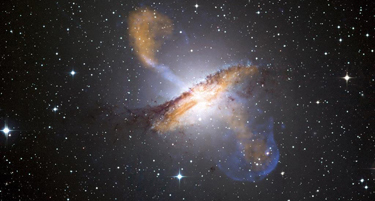
CHAPTER 34 | FRONTIERS OF PHYSICS 1209
34
FRONTIERS OF PHYSICS
Figure 34.1 This galaxy is ejecting huge jets of matter, powered by an immensely massive black hole at its center. (credit: X-ray: NASA/CXC/CfA/R. Kraft et al.)
Learning Objectives
34.1. Cosmology and Particle Physics
• Discuss the expansion of the universe.
• Explain the Big Bang.
34.2. General Relativity and Quantum Gravity
• Explain the effect of gravity on light.
• Discuss black hole.
• Explain quantum gravity.
34.3. Superstrings
• Define Superstring theory.
• Explain the relationship between Superstring theory and the Big Bang.
34.4. Dark Matter and Closure
• Discuss the existence of dark matter.
• Explain neutrino oscillations and their consequences.
34.5. Complexity and Chaos
• Explain complex systems.
• Discuss chaotic behavior of different systems.
34.6. High-temperature Superconductors
• Identify superconductors and their uses.
• Discuss the need for a high-Tc superconductor.
34.7. Some Questions We Know to Ask
• Identify sample questions to be asked on the largest scales.
• Identify sample questions to be asked on the intermediate scale.
• Identify sample questions to be asked on the smallest scales.
Introduction to Frontiers of Physics
Frontiers are exciting. There is mystery, surprise, adventure, and discovery. The satisfaction of finding the answer to a question is made keener by
the fact that the answer always leads to a new question. The picture of nature becomes more complete, yet nature retains its sense of mystery and
never loses its ability to awe us. The view of physics is beautiful looking both backward and forward in time. What marvelous patterns we have
discovered. How clever nature seems in its rules and connections. How awesome. And we continue looking ever deeper and ever further, probing the
basic structure of matter, energy, space, and time and wondering about the scope of the universe, its beginnings and future.
You are now in a wonderful position to explore the forefronts of physics, both the new discoveries and the unanswered questions. With the concepts,
qualitative and quantitative, the problem-solving skills, the feeling for connections among topics, and all the rest you have mastered, you can more
deeply appreciate and enjoy the brief treatments that follow. Years from now you will still enjoy the quest with an insight all the greater for your efforts.
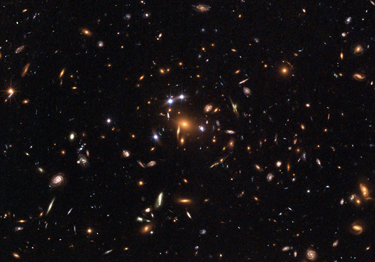
1210 CHAPTER 34 | FRONTIERS OF PHYSICS
34.1 Cosmology and Particle Physics
Look at the sky on some clear night when you are away from city lights. There you will see thousands of individual stars and a faint glowing
background of millions more. The Milky Way, as it has been called since ancient times, is an arm of our galaxy of stars—the word galaxy coming from
the Greek word galaxias, meaning milky. We know a great deal about our Milky Way galaxy and of the billions of other galaxies beyond its fringes.
But they still provoke wonder and awe (see Figure 34.2). And there are still many questions to be answered. Most remarkable when we view the
universe on the large scale is that once again explanations of its character and evolution are tied to the very small scale. Particle physics and the
questions being asked about the very small scales may also have their answers in the very large scales.
Figure 34.2 Take a moment to contemplate these clusters of galaxies, photographed by the Hubble Space Telescope. Trillions of stars linked by gravity in fantastic forms,
glowing with light and showing evidence of undiscovered matter. What are they like, these myriad stars? How did they evolve? What can they tell us of matter, energy, space,
and time? (credit: NASA, ESA, K. Sharon (Tel Aviv University) and E. Ofek (Caltech))
As has been noted in numerous Things Great and Small vignettes, this is not the first time the large has been explained by the small and vice versa.
Newton realized that the nature of gravity on Earth that pulls an apple to the ground could explain the motion of the moon and planets so much
farther away. Minute atoms and molecules explain the chemistry of substances on a much larger scale. Decays of tiny nuclei explain the hot interior
of the Earth. Fusion of nuclei likewise explains the energy of stars. Today, the patterns in particle physics seem to be explaining the evolution and
character of the universe. And the nature of the universe has implications for unexplored regions of particle physics.
Cosmology is the study of the character and evolution of the universe. What are the major characteristics of the universe as we know them today?
First, there are approximately 1011 galaxies in the observable part of the universe. An average galaxy contains more than 1011 stars, with our
Milky Way galaxy being larger than average, both in its number of stars and its dimensions. Ours is a spiral-shaped galaxy with a diameter of about
100,000 light years and a thickness of about 2000 light years in the arms with a central bulge about 10,000 light years across. The Sun lies about
30,000 light years from the center near the galactic plane. There are significant clouds of gas, and there is a halo of less-dense regions of stars
surrounding the main body. (See Figure 34.3.) Evidence strongly suggests the existence of a large amount of additional matter in galaxies that does not produce light—the mysterious dark matter we shall later discuss.

CHAPTER 34 | FRONTIERS OF PHYSICS 1211
Figure 34.3 The Milky Way galaxy is typical of large spiral galaxies in its size, its shape, and the presence of gas and dust. We are fortunate to be in a location where we can see out of the galaxy and observe the vastly larger and fascinating universe around us. (a) Side view. (b) View from above. (c) The Milky Way as seen from Earth. (credits: (a)
NASA, (b) Nick Risinger, (c) Andy)
Distances are great even within our galaxy and are measured in light years (the distance traveled by light in one year). The average distance
between galaxies is on the order of a million light years, but it varies greatly with galaxies forming clusters such as shown in Figure 34.2. The
Magellanic Clouds, for example, are small galaxies close to our own, some 160,000 light years from Earth. The Andromeda galaxy is a large spiral
galaxy like ours and lies 2 million light years away. It is just visible to the naked eye as an extended glow in the Andromeda constellation. Andromeda
is the closest large galaxy in our local group, and we can see some individual stars in it with our larger telescopes. The most distant known galaxy is
14 billion light years from Earth—a truly incredible distance. (See Figure 34.4.)
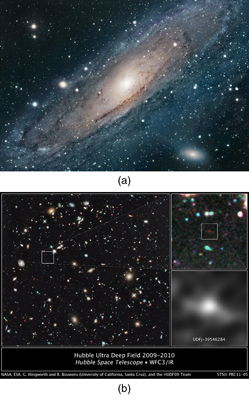
1212 CHAPTER 34 | FRONTIERS OF PHYSICS
Figure 34.4 (a) Andromeda is the closest large galaxy, at 2 million light years distance, and is very similar to our Milky Way. The blue regions harbor young and emerging
stars, while dark streaks are vast clouds of gas and dust. A smaller satellite galaxy is clearly visible. (b) The box indicates what may be the most distant known galaxy,
estimated to be 13 billion light years from us. It exists in a much older part of the universe. (credit: NASA, ESA, G. Illingworth (University of California, Santa Cruz), R. Bouwens
(University of California, Santa Cruz and Leiden University), and the HUDF09 Team)
Consider the fact that the light we receive from these vast distances has been on its way to us for a long time. In fact, the time in years is the same as
the distance in light years. For example, the Andromeda galaxy is 2 million light years away, so that the light now reaching us left it 2 million years
ago. If we could be there now, Andromeda would be different. Similarly, light from the most distant galaxy left it 14 billion years ago. We have an
incredible view of the past when looking great distances. We can try to see if the universe was different then—if distant galaxies are more tightly
packed or have younger-looking stars, for example, than closer galaxies, in which case there has been an evolution in time. But the problem is that
the uncertainties in our data are great. Cosmology is almost typified by these large uncertainties, so that we must be especially cautious in drawing
conclusions. One consequence is that there are more questions than answers, and so there are many competing theories. Another consequence is
that any hard data produce a major result. Discoveries of some importance are being made on a regular basis, the hallmark of a field in its golden
age.
Perhaps the most important characteristic of the universe is that all galaxies except those in our local cluster seem to be moving away from us at
speeds proportional to their distance from our galaxy. It looks as if a gigantic explosion, universally called the Big Bang, threw matter out some
billions of years ago. This amazing conclusion is based on the pioneering work of Edwin Hubble (1889–1953), the American astronomer. In the
1920s, Hubble first demonstrated conclusively that other galaxies, many previously called nebulae or clouds of stars, were outside our own. He then
found that all but the closest galaxies have a red shift in their hydrogen spectra that is proportional to their distance. The explanation is that there is a
cosmological red shift due to the expansion of space itself. The photon wavelength is stretched in transit from the source to the observer. Double
the distance, and the red shift is doubled. While this cosmological red shift is often called a Doppler shift, it is not—space itself is expanding. There is
no center of expansion in the universe. All observers see themselves as stationary; the other objects in space appear to be moving away from them.
Hubble was directly responsible for discovering that the universe was much larger than had previously been imagined and that it had this amazing
characteristic of rapid expansion.
Universal expansion on the scale of galactic clusters (that is, galaxies at smaller distances are not uniformly receding from one another) is an integral
part of modern cosmology. For galaxies farther away than about 50 Mly (50 million light years), the expansion is uniform with variations due to local
motions of galaxies within clusters. A representative recession velocity v can be obtained from the simple formula
v
(34.1)
= H 0 d,
where d is the distance to the galaxy and H 0 is the Hubble constant. The Hubble constant is a central concept in cosmology. Its value is
determined by taking the slope of a graph of velocity versus distance, obtained from red shift measurements, such as shown in Figure 34.5. We shall use an approximate value of H 0 = 20 km/s ⋅ Mly. Thus, v = H 0 d is an average behavior for all but the closest galaxies. For example, a galaxy
100 Mly away (as determined by its size and brightness) typically moves away from us at a speed of
v = (20 km/s ⋅ Mly)(100 Mly) = 2000 km/s. There can be variations in this speed due to so-called local motions or interactions with
neighboring galaxies. Conversely, if a galaxy is found to be moving away from us at speed of 100,000 km/s based on its red shift, it is at a distance
d = v / H 0 = (10 , 000 km/s) / (20 km/s ⋅ Mly) = 5000 Mly = 5 Gly or 5×109 ly . This last calculation is approximate, because it assumes
the expansion rate was the same 5 billion years ago as now. A similar calculation in Hubble’s measurement changed the notion that the universe is in
a steady state.


CHAPTER 34 | FRONTIERS OF PHYSICS 1213
Figure 34.5 This graph of red shift versus distance for galaxies shows a linear relationship, with larger red shifts at greater distances, implying an expanding universe. The
slope gives an approximate value for the expansion rate. (credit: John Cub).
One of the most intriguing developments recently has been the discovery that the expansion of the universe may be faster now than in the past,
rather than slowing due to gravity as expected. Various groups have been looking, in particular, at supernovas in moderately distant galaxies (less
than 1 Gly) to get improved distance measurements. Those distances are larger than expected for the observed galactic red shifts, implying the
expansion was slower when that light was emitted. This has cosmological consequences that are discussed in Dark Matter and Closure. The first
results, published in 1999, are only the beginning of emerging data, with astronomy now entering a data-rich era.
Figure 34.6 shows how the recession of galaxies looks like the remnants of a gigantic explosion, the famous Big Bang. Extrapolating backward in
time, the Big Bang would have occurred between 13 and 15 billion years ago when all matter would have been at a point. Questions instantly arise.
What caused the explosion? What happened before the Big Bang? Was there a before, or did time start then? Will the universe expand forever, or
will gravity reverse it into a Big Crunch? And is there other evidence of the Big Bang besides the well-documented red shifts?
Figure 34.6 Galaxies are flying apart from one another, with the more distant moving faster as if a primordial explosion expelled the matter from which they formed. The most
distant known galaxies move nearly at the speed of light relative to us.
The Russian-born American physicist George Gamow (1904–1968) was among the first to note that, if there was a Big Bang, the remnants of the
primordial fireball should still be evident and should be blackbody radiation. Since the radiation from this fireball has been traveling to us since shortly
after the Big Bang, its wavelengths should be greatly stretched. It will look as if the fireball has cooled in the billions of years since the Big Bang.
Gamow and collaborators predicted in the late 1940s that there should be blackbody radiation from the explosion filling space with a characteristic
temperature of about 7 K. Such blackbody radiation would have its peak intensity in the microwave part of the spectrum. (See Figure 34.7.) In 1964,
Arno Penzias and Robert Wilson, two American scientists working with Bell Telephone Laboratories on a low-noise radio antenna, detected the
radiation and eventually recognized it for what it is.
Figure 34.7(b) shows the spectrum of this microwave radiation that permeates space and is of cosmic origin. It is the most perfect blackbody
spectrum known, and the temperature of the fireball remnant is determined from it to be 2.725 ± 0.002K . The detection of what is now called the
cosmic microwave background (CMBR) was so important (generally considered as important as Hubble’s detection that the galactic red shift is
proportional to distance) that virtually every scientist has accepted the expansion of the universe as fact. Penzias and Wilson shared the 1978 Nobel
Prize in Physics for their discovery.
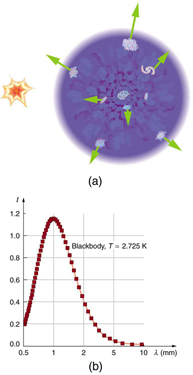
1214 CHAPTER 34 | FRONTIERS OF PHYSICS
Figure 34.7 (a) The Big Bang is used to explain the present observed expansion of the universe. It was an incredibly energetic explosion some 10 to 20 billion years ago. After
expanding and cooling, galaxies form inside the now-cold remnants of the primordial fireball. (b) The spectrum of cosmic microwave radiation is the most perfect blackbody
spectrum ever detected. It is characteristic of a temperature of 2.725 K, the expansion-cooled temperature of the Big Bang’s remnant. This radiation can be measured coming
from any direction in space not obscured by some other source. It is compelling evidence of the creation of the universe in a gigantic explosion, already indicated by galactic
red shifts.
Making Connections: Cosmology and Particle Physics
There are many connections of cosmology—by definition involving physics on the largest scale—with particle physics—by definition physics on
the smallest scale. Among these are the dominance of matter over antimatter, the nearly perfect uniformity of the cosmic microwave background,
and the mere existence of galaxies.
Matter versus antimatter We know from direct observation that antimatter is rare. The Earth and the solar system are nearly pure matter. Space
probes and cosmic rays give direct evidence—the landing of the Viking probes on Mars would have been spectacular explosions of mutual
annihilation energy if Mars were antimatter. We also know that most of the universe is dominated by matter. This is proven by the lack of annihilation
radiation coming to us from space, particularly the relative absence of 0.511-MeV γ rays created by the mutual annihilation of electrons and
positrons. It seemed possible that there could be entire solar systems or galaxies made of antimatter in perfect symmetry with our matter-dominated
systems. But the interactions between stars and galaxies would sometimes bring matter and antimatter together in large amounts. The annihil











